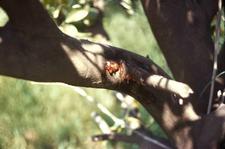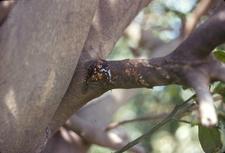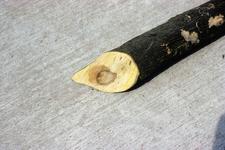Rio Grande Gummosis
HISTORY, DISTRIBUTION AND IMPORTANCE
Rio Grande gummosis (RGG) is a disorder of the trunk and limbs of mature citrus trees. It occurs primarily in the Caribbean Basin, Somalia and Morocco but has been reported sporadically from other citrus areas. Grapefruit and lemon are the most commonly affected species, but it may occur on any species of citrus.
NAME OF DISEASE AND SYNONYMS
Abbreviation: RGG for Rio Grande Gummosis.
SYMPTOMATOLOGY
The first sign of RGG is usually some narrow cracks that occur in the bark and exude pale yellow gum (RGG. 01, 02). Extensive gum production may follow and trees may be severely affected (RGG. 03). However, since the gum is water soluble, it may disappear after heavy rains. In severe cases, the trunk and scaffold branches take on a black/charred appearance extending up to 100 cm from the lesion. The bark around the edge of the lesion is usually orange to salmon-colored and if the bark is removed, the cambial tissue turns a pink to orange color. This discoloration may also be seen in the wood, if the limb is cut off (RGG. 04). As the lesions age, they become darker and the wood tissues become impregnated with gum. If the bark dies and wood is exposed, decay may develop in the advanced stages of the disease. Sometimes trees recover from the disease at least temporarily. Trees showing extensive gumming and some bark necrosis one year, may appear nearly normal the next with little gummosis. If limbs are girdled by bark necrosis, death of the entire limb occurs. The disease has historically been considered to only occur in older trees (20+ years), but recent field studies and surreys on the east coast of Florida have found early symptoms to occur in 7-year-old grapefruit and moderate symptoms in 15-year-old grapefruit.
CAUSAL AGENT: DESCRIPTION AND PROPERTIES
The cause of the disease is uncertain. It has been variously attributed to soil conditions and fertilization, viruses and wood-attacking fungi. In Florida, the disease has been associated with an uncharacterized, graft-transmissible agent, but that agent proved to be unrelated to psorosis. Long-term studies with graft-inoculated trees have shown that this agent does not spread naturally in the field, but is associated with a significantly increased percentage and severity of RGG symptoms. However, trees without the agent may also develop the disease. The disease is aggravated by application of chlorides and other fertilizer salts and occurs more commonly on calcareous soils or those with calcareous subsurface layers. A number of different fungi can be isolated from affected trunk or branch wood, but most of these are common saprophytes in citrus groves. Inoculations with fungi such as Lasiodiplodia theobromae induce extensive gumming and some necrosis of wood, but this also occurs with a number of other saprophytes and weak pathogens associated with citrus. Thus, it is still unclear whether these fungi actually cause the disease. However, Rio Grande gummosis almost never occurs on young trees and is often associated with areas of the tree with large pruning wounds, freeze cankers, and broken branches. So it is possible that fungi entering these wounds colonize the wood spreading and breaking out elsewhere on the tree.
HOST RANGE
Grapefruit and lemon are the most commonly affected species, but it may occur on any species of citrus.
TRANSMISSION
Unknown.
EPIDEMIOLOGY
Unknown.
DIAGNOSIS
Observation of field symptoms. No diagnostic tests available.
CONTROL
No control measures are known for the disease except to avoid making large pruning wounds near the trunk.
SELECTED REFERENCES
Calavan, E.C. (1961) Ferment gum disease (Rio Grande gummosis) of grapefruit. Calif. Citrogr. 46, 231-232.
Childs, J.F.L. (1978) Rio Grande gummosis of citrus trees. Part I. A brief review of the history and occurrence of Rio Grande gummosis. Plant Dis. Rep. 62, 390-394.
Childs, J.F.L. (1978) Rio Grande gummosis of citrus trees. Part II. The causal relations of Rio Grande gummosis. Plant Dis. Rep. 62, 395-399.
Davis, R.M. (1980) Evidence for the involvement of Diplodia natalensis in Rio Grande gummosis of citrus. J. Rio Grande Val. Hortic. Soc. 34, 55-60.
Powell, C.A., R.R. Pelosi, R.M. Sonoda, R.F. Lee. (1998) A psorosis-like agent prevalent in Florida’s grapefruit groves and budwood sources. Plant Dis. 82, 208-209.
Sonoda, R.M., R.R. Pelosi. (1990) Fungi in Rio Grande gummosis lesions and patterns of gummosis-affected grapefruit trees in Indian River area groves. Proc. Fla. State Hortic. Soc. 103, 59-61.
Sonoda, R.M., R.R. Pelosi, J.W. Hebb. (1992) Comparing Rio Grande gummosis and citrus blight on grapefruit on Swingle citrumelo rootstock. Proc. Fla. State Hortic. Soc. 105, 28-32.
Prepared (2006) by L. W. Timmer and C.A. Powell
Department of Plant Pathology
University of Florida, IFAS
Citrus Research and Education Center
700 Experiment Station Road
Lake Alfred, FL 33850
(USA)
Click on any image to make it larger.
PHOTOS |
LEGENDS AND AUTHORS |
|---|---|
|
Gumming of the scaffold limb of a grapefruit tree (Texas, USA) Photo by L. W. Timmer |
|
|
Gumming at the base of a dead branch (Texas, USA) Photo by L. W. Timmer |
|
|
Severe Rio Grand gummosis on a grapefruit tree in Florida (Florida, USA) Photo by R. R. Pelosi. |
|
|
Pink-orange discoloration of wood on a branch affected by Rio Grande gummosis (Texas) Photo by L. W. Timmer. |




